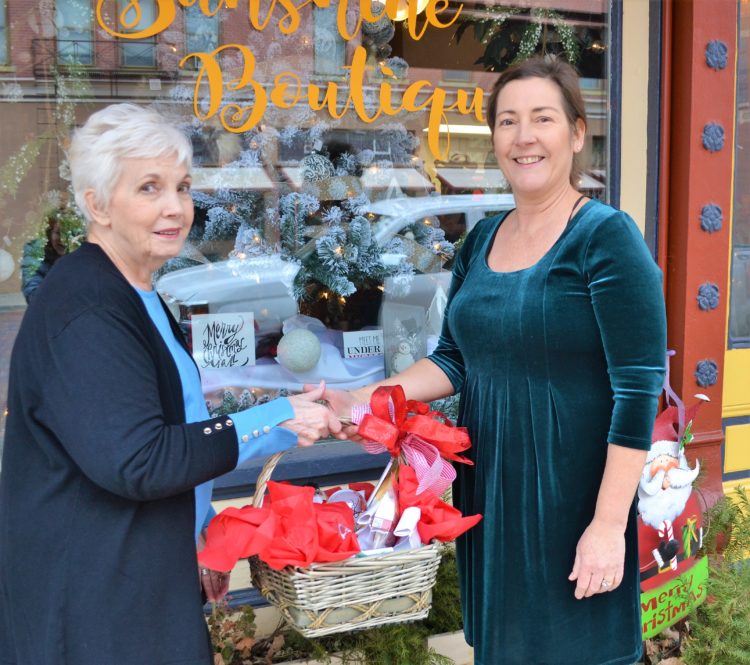These are the Fort Scott Police Department’s daily reports from Jan. 21.
From subscriber responses, these reports are best viewed by computer, not a cell phone.
These are the Fort Scott Police Department’s daily reports from Jan. 21.
From subscriber responses, these reports are best viewed by computer, not a cell phone.
Kansas State University will host a series of meetings to help beef producers focus on management and profit strategies for the new year.
Bob Weaber, a K-State Research and Extension cow-calf specialist, said this year’s Winter Ranch Management series is titled ‘Corrals, calcium, costs and cows: management and profit strategies for 2018.’ The meetings will be held at four sites in Kansas and will feature presentations and comments by extension educators on profit-enhancing strategies.
The meetings will also feature a popular ‘town-hall’ style question-and-answer session between Kansas’ cattle producers and extension specialists. Weaber sid the series has a history of being a successful stretch of meetings.
Weaber, along with other state, district and local extension staff, will take part in the series to help answer producers’ questions. The specialists will answer a wide range of questions on beef cattle issues including animal health, nutrition, management, genetics and reproduction.
“Over the past few months we’ve received quite a few questions from producers looking for profit tips and tools,” Weaber said. “The Winter Ranch Management series provides another great opportunity for state and local specialists to take our expertise out in the country for a series of impactful face-to-face meetings.
“During the last few years producers have experienced price volatility and increased costs. We believe that producer profit margins will continue to narrow over the next couple of years. Our extension team is here to help with reliable information.”
Meeting topics include facility improvements and bud box cattle processing systems; mineral supplementation strategies; cost; production and profit benchmarking; and optimizing the cow herd through female selection. The Hepler location will feature a talk by Kansas State University rangeland specialist KC Olson on late season burning as a method to aid in the control of sericea lespedeza.
“Early in the year is a great time for producers, to think and plan for the coming year,” Weaber said. “Certainly, it is a good time of year to think about opportunities to reduce costs and enhance revenue streams.”
The Hepler, Kansas meeting will take place on Tuesday, February 13 frpm 5:30 – 8:30 p.m. at the Community Building located on the south end of Hepler, Kansas. This meeting is sponsored by Merck Animal Health. A $10 fee payable at the door will cover meals and materials. please RSVP by February 6, 2018, to Chris Petty, Southwind Extension District, 620-223-3720 or [email protected] or Keith Martin, Wildcat Extension District, 620-784-5337 or [email protected]
More information on the meetings is available at www.KSUBeef.org.
The Fort Scott City Commission will meet this evening at 6 p.m. at city hall, 123 S. Main Street.
On the agenda:
CONSENT AGENDA:
A. Approval of minutes of the regular meeting of December 19th, 2017.
B. Approval of Appropriation Ordinance 1206-A totaling $407,293.46.
C. Resolution 1-2018 designating the official City newspaper.
D. Resolution 2-2018 designating the official City depositories for public
funds
E. Certificate of Appropriateness – Proposed changes to building and
signage at 2 N. Main Street
VI. REORGANIZATION OF CITY COMMISSION AND ELECTION OF
MAYOR, COMMISSION PRESIDENT, B.C.E.D.C.I.
REPRESENTATIVE, AND FORT SCOTT HOUSING AUTHORITY
DELEGATE
a. Swearing in of new Commissioners
b. Election of Mayor
c. Election of Commission President
d. Election of Bourbon County Economic Development Council
Inc. Representative
e. Election of Fort Scott Housing Authority Delegate
VI. APPEARANCE/COMMENTS/PUBLIC HEARING:
A. APPEARANCE:
B. CITIZEN COMMENTS (Concerning Items Not on Agenda – 3 minute
limit per citizen)
C. PUBLIC HEARINGS/COMMENTS: None
VII. CONSIDERATION:
1. Approval of Fort Scott Plumbing Board reappointments – 3 year
terms
2. Approval of Fort Scott Electrical Board reappointments – 3 year
terms
VIII. COMMENTS:
A. Director Updates:
B. Commission:
C. City Attorney:
D. Director of Finance:
E. City Manager:
EXECUTIVE SESSION:
Justifications for Executive Sessions:
• Personnel matters of non-elected personnel
• Consultation with an attorney for the body or agency which would be
deemed privileged in the attorney-client relationship
• Matters relating to employer-employee negotiations whether or not in
consultation with the representative or representatives of the body or
agency
• Confidential data relating to financial affairs or trade secrets of
corporations, partnerships, trusts and individual proprietorships
• Preliminary discussions relating to the acquisition of real property
IV. MOTION FOR ADJOURNMENT: ROLL CALL
Barbara Ritter is the winner of the Sunshine Boutique Gift Basket after being randomly selected from FortScott.Biz subscribers. A big thank you to Sunshine Boutique for sponsoring the giveaway!

|

The Bourbon County Commission meets at 9 a.m. on Tuesdays at the county courthouse, 210 S. National Ave.
The agenda for December 12, 2017:
9-9:45 a.m.-Jim Harris
9 a.m.-City State Bank – John Hill-Financing paperwork for the Mack Dump Truck
9:45-10:15 a.m.- Commissioners consider and take action on any and all question regarding the law enforcement project
10:30-10:45 a.m.-Bobby Reed-Budget
11-11:30 a.m.-Justin Meeks
11:30 a.m.-1:30 p.m.-Jail Progress Meeting
1:45-2 p.m.-Clint Anderson
2:30 p.m.-Employee handbook
1st District Commissioner is Lynne Oharah; 2nd District-Jeff Fischer; 3rd District-Nick Ruhl and the County Clerk-Kendell Mason
Justifications for Executive Session:
· Personnel matters of individual non-elected personnel
· Consultation with an attorney for the body or agency which would be deemed privileged in the attorney-client relationship
· Matters relating to employer-employee negotiations whether or not in consultation with the representative(s) of the body or agency
· Confidential data relating to financial affairs or trade secrets of corporations, partnerships, trusts and individual proprietorships
· Preliminary discussions relating to the acquisition of real property
· Matters relating to the security of a public body or agency, public building or facility or the information system of a public body or agency, if the discussion of such matters at an open meeting would jeopardize the security of such public body, agency, building, facility or information system
|
8 |
This compilation provided by the Fort Scott Chamber of Commerce
Improv Comedy Troupe by FSHS Thespians, Common Ground, 7-9pm, Join us for a night of laughs as the Fort Scott High School Thespian Improv Troupe performs comedy sketches created on the spot using audience suggestions. A $5 donation is requested as admission. |
| 8 | Bourbon County CASA fundraising event, 7-9pm, home of Crystal Mason and Elaine Kirby. Contact is Christa Horn, 620-215-2769. |
| 8 | Theology on Tap, Beaux Arts Centre, 7pm. First Presbyterian Invites you to Experience Theology on Tap. “Beer (Wine) and Carols” All are welcome! Bring an appetizer or beverage of your choice. |
| 9 | Christmas at BRCC, 735 Scott Ave., Secret Santa Rummage Sale, proceeds go to Adopt-A-Family, 8am-2pm, by donation unless marked. Biscuits & gravy in the morning, hamburger vegetable soup for lunch or supper – items served all day. |
| 9 | KS Rocks Recreation Park Wheeling 4 Toys Sponsored by the Brush Beaters Jeep Club. This great event collects toys for underprivileged children n the area. pre-registration includes shirts, meals and dash plaques. A great way to start off your Holiday Season. Closed to open riding. |
| 9 | “The Ugly Sweater Tasting” at East Side Liquor, 1516 E. Wall St., starting at 11am, tasting of some local wines and new whiskeys. |
| 9-10 | FSHS Thespians “How the Grinch Stole Christmas” performance. Performances at 2 and 7pm on Dec 9. Performance at 2pm on Dec 10. Click HERE for more info. |
| 9 | Lowell Milken Center for Unsung Heroes Book Reading & Signing. Join the author Cathy Werling for a reading of her first book in a new children’s book series, “Why Did Grandpa Cry?” Readings at 10am & 11am with signing to follow each reading. There will also be 2 different drawings. One for a free book, and one for a lunch with the author! This event is FREE to the public. Click HERE for more details. |
Things to do 2017 December 1-3
Check out the Fort Scott Chamber of Commerce link for a multitude of activities this weekend.
Submitted story
As Thanksgiving leftovers are packed into the refrigerator, talk of Christmas decorating starts to fill the air. Awareness can help ensure that holiday lights and decorations are installed and operated safely. Westar Energy offers the following tips.
Before using strands of lights or other decorations, check them for signs of damage, paying special attention to electrical cords. Signs of wear or fraying cords mean that lights may be unsafe and should be replaced.
Consider replacing incandescent bulbs with LEDs. New LED bulbs use less energy and produce less heat than their older counterparts.
Don’t overload power outlets by stringing together too many strands of lights or plugging too many into a single outlet. Lighting packages may say how many strands can be safely combined. Using surge strips with built-in circuit breakers can also protect against overload.
Before raising a ladder, climbing a tree or securing an inflatable, look up for nearby powerlines. If climbing onto tree limbs, make sure the extra weight will not cause limbs to contact power lines. Contact with overhead power lines can severely injure or kill someone.
Be sure that lights, decorations and extension cords used outdoors are designed for outside use, which may include exposure to wet weather. Cords with surge protectors are recommended.
Ensure that lights are fastened securely. Avoid stringing lights on metal decorations or fences that could become charged, creating the risk of electric shock.
As Kansas’ largest electric utility, Westar Energy, Inc. (NYSE:WR) provides customers the safe, reliable electricity needed to power their businesses and homes. We have 7,800 MW of electric generation capacity that includes renewables and traditional power sources with half the electricity supplied to our more than 700,000 customers from emissions-free sources: nuclear, wind and solar, with a third coming from renewables. We are a leader in electric transmission in Kansas coordinating a network of lines and substations that supports one of the largest consolidations of wind energy in the nation. Our employees live, volunteer and work in the communities we serve.
For more information about Westar Energy, visit us on the Internet at http://www.WestarEnergy.com. Westar Energy is on Facebook: www.Facebook.com/westarenergy and Twitter: www.Twitter.com/WestarEnergy.
FORT SCOTT, Kan. (Nov. 9, 2017) — Mercy Hospital Fort Scott will host a Diabetes Support Group on Monday, November 20 at 6 p.m. in the McAuley Conference Center. The session topic is “Diabetes Medications: A look at what’s new in the treatment of diabetes.”
Patty Ryan, Mercy R.N., a diabetes educator, will lead the discussion and share details about options that may work for you.
The support group is open to the public. No registration is required and family members are encouraged to attend. Light refreshments will be served.
To learn more about this topic or other important information regarding managing diabetes, join the Mercy Diabetes Support Group. The group meets the third Monday of every other month. Mark your calendar for meeting dates of 2018: January 15; March 19; May 21; July 16; and September 17.
For more information, contact Patty Ryan, R.N., at 620-223-8412.